How to Exercise on a Stationary Bike? Tips & Advice
The WHO recommends exercising for 1 hour 15 minutes throughout the week. Physical exercise has positive effects on your heart and lungs, increases your life expectancy, improves your intellectual abilities, lowers the risk of Alzheimer's and could even make you...happier! Ideally you should have a physical activity, such as training on an exercise bike, 2 or 3 times per week between 30 and 40 minutes each time (and get the most of the positive effects of exercising).
1) No effective workout on your exercise bike without the right position
The seat. Adjust it according to the height of your hips. Most upright exercise bikes have an adjustable seat (this is not the same position on a recumbent bike).
Position on the bike. Once seated on your home exercise bike, your knee should be slightly bended (5 to 10 degrees) when the pedal is at the very bottom. You will not hurt your joints and your back will appreciate it!
Position of the back. As you lean forward you will gain more cycling power but lose in comfort. There are 3 positions of the back possible:
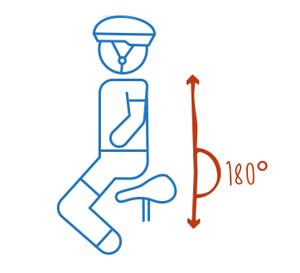
Straight back
Comfort ***
Power *
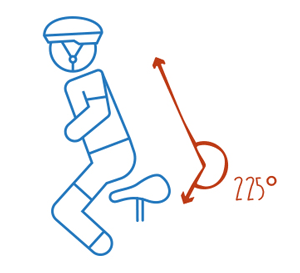
Back tilted slightly forward
Comfort **
Power **
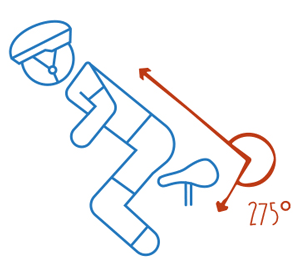
Inclined Back
Comfort *
Power **
2) All you need to know about how to exercise on a stationary bike!
Training includes a warm-up phase, a cardio training phase (which is more intense) and a recovery phase. If you want to make real progress or burn calories, our training advice is to ride a stationary bike for at least 30 minutes.
a. The warm-up
You should never forget to warm-up! Warming up means that you prepare your muscles to an intensive use. During the warm-up phase, you progressively increase your cardiac rhythm and your body temperature. The warm-up period must last between 5 and 10 minutes: 5 minutes of stretching (5 seconds per muscle) then 5 minutes of cycling at a moderate pace (70-80 rounds per minute) on the indoor bike.
Stretching. The 4 stretching exercises before riding a stationary bicycle:
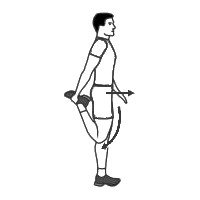
Quadriceps
Stand up, take your ankle and bring your heel towards your buttock.
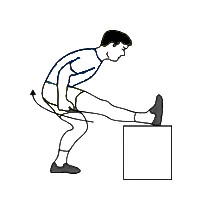
Legs
Whilst standing up, put your leg on a chair and keep it stretched. Lean forward.
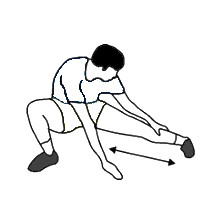
Abductor muscles
Spreading out your legs, bend one leg and keep the other one extended.
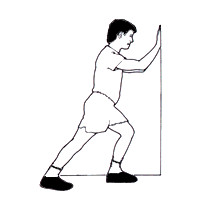
Calves
Against a wall, stretch one leg back whilst keeping your heel on the ground.
b. The recovery
If you want to avoid muscle soreness, then the recovery period after your cardio workout session is key! It consists of a warm-up but… the other way round: gently cycle for 5 minutes around 80 RPM (Rounds Per Minute) and then stretch your muscles during an extra 5 minutes.
c. The training indicators on a stationary bike
In order to have an efficient cardio workout, it is important to understand the various indicators on a bike, such as the pedalling cadence, the watts and the pulse.
WATT
Cycling power produced
RPM (rounds per minute)
Pedalling cadence: Number of pedal rounds per minute
BPM (beats per minute)
Heart rate: Number of heart beats per minute
Calories (Kcal)
Energy burnt during a training session
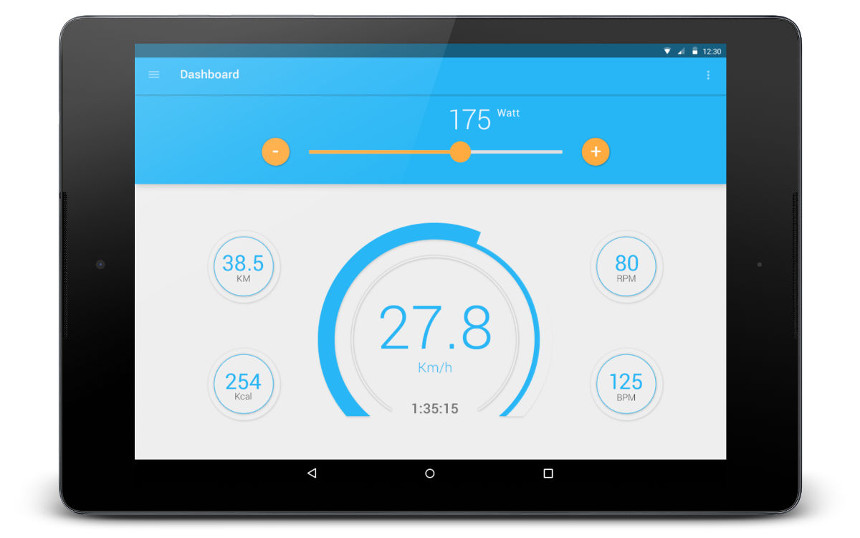
The Vescape App offers training programs for home exercise bike
d. Choosing a training mode
1. Training according to the cadence (RPM) and the cycling power (Watts)
This is the classic indoor bike workout.
The cadence. Our training advice is to keep a cadence (number of pedal rounds per minute) between 80 and 100 rounds of pedal per minute. When you work out on your stationary bike for a long period of time or when you increase your cycling power (watts) it is however normal that your cadence lowers. It is a more precise indicator than the speed in kilometres per hour on an indoor bike as speed may differ from one bike to another.
The pedalling power. Watts indicate your cycling power when you are riding an exercise bike. Watts are a better indicator than the resistance level since the resistance level may vary from one bike to another. The watts take into account your speed, which means that if you cycle at 160 watts at 90 rpm and suddenly reduce your speed at 60 rpm, then the resistance level of your stationary bike will automatically adjust and in this case increase so that your cycling power remains constant at 160 watts. All professional cyclists use watts as a training indicator and not the resistance level of the exercise bikes.
Two examples of training exercises on an indoor bike.
Programme 1. Getting back in shape
• Warm-up for 5-10 minutes
• Train for 20 minutes:
- 2 min 60 Watt
- 2 min 80 watt
- 4 min 100 watt
- 4 min 120 watt
- 4 min 100 watt
- 2 min 80 watt
- 2 min 60 watt
• Recover for 10 minutes
Programme 2. Endurance
• Warm-up for 5-10 minutes
• Train for 20 minutes:
- 2 min 60 Watt
- 2 min 80 watt
- 4 min 100 watt
- 4 min 120 watt
- 4 min 140 watt
- 2 min 160 watt
- 2 min 180 watt
• Recover for 10 minutes
2. High Intensity Interval Training (HIIT)
HIIT is a cardio workout which alternates between intensive exercise phases (high intensity intervals) and recovery phases (low intensity intervals). Interval training, also known as fractionated training, is very demanding. This cardiovascular exercise enables you to considerably increase you physical abilities in a very short period of time.
Two HIIT workout routines for stationary bikes:
HIIT Programme 1
• Warm-up for 10 minutes
• HIIT for 16 minutes:
- 1 min intensively - 1 min recovery
- Repeat 8 times
- The intensity should be between 80 and 90% of your maximal perceived effort
• Recover for 10 minutes
HIIT Tabata* Programme 2
• Warm-up for 10 minutes
• HIIT for 12 minutes:
- 20 sec intensively - 10 secs recovery
- Repeat 8 times- 4 min at 80 RPM - Repeat 8 times
- The intensity should be between 80 and 90% of your maximal perceived effort
• Recover for 10 minutes
* Tabata. Intensive version of the HIIT workout which was developed by Professor Izumi Tabata after he analysed the training efficiency of the Japanese speed skating team.
BEWARE: Only follow these HIIT workouts if you are physically fit because interval trainings are very demanding! If you are starting again to exercise, we advise you to follow these HIIT training programmes only after 2 or 3 months. Interval trainings allow you to train in the anaerobic zone (see training zones below).
-
3. Training according to pulse / heart rate (training zone)
a. What are training zones?
Training zones designate various levels of heart rates. Knowing these zones allows you to regulate the intensity of your physical activity and achieve your goals more easily.
When you exercise at a low heart rate training zone, your body uses your fat stock. This is the zone you have to aim for if you want to lose fat.
On the other hand, the more intense your physical activity is and your heart rate high, the more will your body need a quick supply of energy and will use your sugar stock. If your goal is to improve your performance, your speed and your endurance, then you have to aim for high training zones, which are reached with HIIT trainings for example.
b. Maximal Heart Rate
First you have to calculate your Maximal Heart Rate (MHR) with this simple formula.
For a man : MHR = 220 – age
For a woman : MHR = 226 – age
For example, a 35-year-old man has a MHR of 185 (220-35) and a 35-year-old woman has got a MHR of 191 (226-35).
A 60-year-old man has a MHR of 160 and a 60-year-old woman has got a MHR of 166. Your max heart rate depends on your sex and your age.
c. How to choose your heart rate training zone?
90%-100% of the MHR
80%-90% of the MHR
70%-80% of the MHR
60%-70% of the MHR
50%-60% of the MHR
Training zones chart according to your Maximal Heart Rate
* anaerobic. (= lack of oxygen) In this state, the lungs and the heart can not supply enough oxygen to the body. Consequently it has to dig into the sugar stock in order to produce energy. The body produces waste (lactic acid) in the anaerobic zone.
* aerobic. Muscles consume oxygen supplied by breathing and the body produces power by burning fat. In the aerobic zone, the body recuperates the lactic acid and transforms it again into energy.
NOTE: Training in the anaerobic zone does not mean that you will not lose weight! However if you are exercising on a stationary bike with the aim of losing weight, you should try to follow an aerobic exercise. If your goal is to muscle your legs, then our training advice is to target the anaerobic zone.
3) What should you drink and eat before, during and after the training exercise?
What should you drink?
Most important rule: Do not wait to be thirsty or to have a dry throat to drink!
- Drink before, during and after your exercise bike workout.
- During your exercise session, drink at least 2 sips of water (10 to 20 cl) every 10-15 minutes.
- If your exercise for more than 1 hour, you should drink an energy drink in order to stay hydrated.
What should you eat?
In order to have an efficient cardio workout, an adapted nutrition is essential before as well as after a physical activity.
Before the exercise session, you should preferably eat carbohydrates which will be found in rice and pasta for example, as it will provide an important amount of energy.
After your workout, you will need to «refuel», preferably proteins, that you will find in eggs, yoghurts and dried fruits. Even if your aim is to lose weight, it is absolutely key to eat after your workout session as your body will need to regenerate itself.
| Period before exercise | Food |
|---|---|
| < 1h | Yoghurt, banana, muffin |
| 1h-2h | Porridge, smoothie, chicken sandwich |
| 2h-3h | Bread, pasta, eggs, cheese |
| 3h-4h | Balanced meal |
After the workout (in the 30 minutes following the exercise)
- Banana + 1 glass of chocolate milk
- Natural Yoghurt + 1 cereal bar
- Dried Fruits
- Smoothie
From now on, you know (almost) everything about how to use an exercise bike! If you follow our training advice on how to exercise on a stationary bike then you will train efficiently without any problem! Read below a summary of our training tips.
REMEMBER
- WHO recommends having a weekly intensive physical activity of 1h15.
- A good position on your stationary bike is key as it will prevent you from damaging your back.
- Warming up for 5-10 minutes is essential as you need to warm up your muscles.
- You must always finish with a recovery period of 5-10 minutes to prevent soreness the next day.
- 2 ways to exercise: according to the cadence (RPM) and the power (watts) or according to the heart rate.
- Follow an aerobic workout (70-80% of your MHR) if your aim is to lose weight.
- Train in the anaerobic zone (80-90% of your MHR) if your goal is to improve your performance.
- During a cardio workout drink at least 2 sips of water every 10-15 minutes.
- Eat a light meal 1 hour before exercising (yoghurt, banana) and then in the 30 minutes following it (dried fruits).
David Anderson is a professional writer with 15 years of experience in the sports and fitness industry. He has been writing about fitness and giving workout tips and advice for the Vescape Fitness Shop since 2016.





